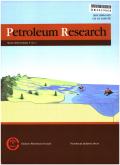Identification and tracing of near-source petroleum transport system based on reservoir bitumen index (RBI) method: A case study of the lower cambrian in the Tazhong-Bachu area, Tarim Basin, China
IF 4
Q1 Earth and Planetary Sciences
引用次数: 0
Abstract
The exploration of deep layers has become increasingly important in the global oil and gas industry. The Tazhong-Bachu area of the Tarim Basin is a pioneering target for deep petroleum exploration in China, but only Wells Zhongshen1 and Zhongshen5 have found industrial oil flow in the Cambrian. Noteworthily, the occurrence of reservoir bitumen in the Lower Cambrian coring interval in many wells indicates that large-scale hydrocarbon migration had occurred here in geological history. Effective identification of reservoir bitumen in the Cambrian dolomite reservoirs is crucial to understanding hydrocarbons' distribution and migration. In this study, we adopt the Reservoir Bitumen Index (RBI) method to deduce a quantitative calculation formula for reservoir bitumen, and classify the transport system into four types based on differences in hydrocarbon transport behavior and characteristics. The results show that the deep carbonate low permeability-tight reservoirs of the Lower Cambrian in the Tazhong-Bachu area generally develop reservoir bitumen, most likely derived from underlying Precambrian source rocks. Therefore, the Lower Cambrian carbonate reservoir is considered a near-source discrete petroleum transport system, providing great potential for further oil and gas exploration in the Lower Paleozoic in the Tazhong-Bachu area.
基于储层沥青指数(RBI)方法的近源油气输运系统识别与示踪——以塔里木盆地塔中-巴楚地区下寒武统为例
在全球油气行业中,深层勘探已变得越来越重要。塔里木盆地塔中—巴楚地区是中国深部油气勘探的先导区,但仅有中深1井和中深5井发现了寒武系工业油流。值得注意的是,下寒武统多口井取心段储层沥青的出现,表明该区在地质历史上曾发生过大规模的油气运移。有效识别寒武系白云岩储层中的储层沥青对认识油气的分布和运移具有重要意义。采用储层沥青指数(RBI)方法推导出储层沥青的定量计算公式,并根据油气输运行为和特征的差异将储层沥青输运系统划分为4种类型。结果表明,塔中-巴楚地区下寒武统深层碳酸盐岩低渗致密储层普遍发育储层沥青,沥青很可能来源于下伏前寒武统烃源岩。因此,下寒武统碳酸盐岩储层被认为是一个近源离散油气输导系统,为塔中-巴楚地区下古生界进一步勘探提供了巨大的潜力。
本文章由计算机程序翻译,如有差异,请以英文原文为准。
求助全文
约1分钟内获得全文
求助全文
来源期刊

Petroleum Research
Earth and Planetary Sciences-Geology
CiteScore
7.10
自引率
0.00%
发文量
90
审稿时长
35 weeks
 求助内容:
求助内容: 应助结果提醒方式:
应助结果提醒方式:


